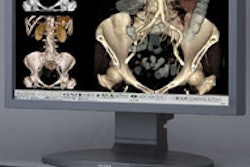PACS can do wonders for improving workflow processes in radiology, but a paperless environment is what's really needed to optimize throughput and overall efficiency, according to Dr. Paul Chang of the University of Pittsburgh Medical Center (UPMC).
"Getting rid of film and filming is an important first step," Chang said. "However, one must also get rid of paper, the other information baton."
Chang spoke during a talk at PACS 2005: The Expanding Integrated Digital Healthcare Enterprise, a March conference in San Antonio sponsored by the University of Rochester School of Medicine & Dentistry in Rochester, NY.
Radiology today faces a number of challenges, including advances in data acquisition that are producing increasingly larger and more complex image datasets, Chang said. Clinicians are utilizing improved treatment options that require more precise diagnosis and staging from radiology, and healthcare enterprises are becoming increasingly complex and physically distributed.
At the same time, radiology faces increased expectations from both referring physicians and patients, while grappling with significant economic and staffing constraints, he said.
Improving patient throughput
Increasing patient throughput will decrease delay in diagnosis and patient length of stay, as well as reduce the backlog of elective outpatient studies. In addition, it will maximize revenue generation and improve patient satisfaction, Chang said.
However, many barriers block efficiency in radiology, including a workflow design based on film and paper information delivery and excessive time spent on peripheral tasks, he said.
Radiology is often characterized by an inflexible "serialized" workflow model; film and paper are used as information batons to be passed between technologists and radiologists, Chang said.
But this type of process does not scale well to large and distributed practices. And some institutions have pursued layoffs of full-time employees such as transport staff and nurses, indicating a shortsighted perspective that hinders department efficiency, he said.
Gaining efficiency is not achieved just by speeding patient throughput; improved information throughput is the real goal, Chang said. Peripheral tasks must be eliminated or minimized.
The goal of informatics is to sever the hard linkage between technologist workflow and radiologist workflow, he said. Radiology's serialized workflow model must change to a more flexible asynchronous parallel model.
This requires the elimination of film and paper, and the adoption of electronic-based informatics systems. Tighter integration of electronic information systems and re-engineering of all workflow for maximum leverage of electronic infrastructure are also needed to complete the job, Chang said.
Going paperless
Getting rid of paper, however, can be very challenging. The traditional paper requisition serves many workflow functions, including informing the radiologist that a study needs to be interpreted, Chang said.
"I'm amazed at how many (sites that) have PACS and have worklists, and they still use reqs," he said. "Why do they still use reqs when you have worklists? It's because a lot of the time you can't trust the worklist. (For example), if there's not tight integration with the dictation system, a lot of people (believe) that two radiologists (could be) reading the same study because there's not a rapid interface."
The traditional paper requisition also contains clinical information and context, and frequently serves as the interface to the dictation system, Chang said.
In an effort to re-engineer technologist workflow, UPMC utilized a Web client that serves as technologist worklist and interface to the PACS. When a technologist scans the patient, the image pops up, and the technologist can click "study complete," he said. The application also performs tasks such as ensuring storage commitment and counting images to ensure they are all there before sending the studies on.
"More importantly, for stat cases like trauma, ICU, and ED cases, there's a stat (function) that will automatically page the appropriate reading room," he said. "That's why we don't have an ED radiologist in our ED. Every single ED case 24/7 is interpreted by a subspecialist."
An automated exception handler is included in the application, allowing technologists the ability to fix exceptions as they occur, Chang said. "Our techs love this because they used to get yelled at because there was an error," he said. "Now they can fix it and nobody will care."
In a paperless environment without traditional requisitions, radiologists need a worklist that is completely trustworthy. There's no safety net, he said.
With UPMC's distributed radiology environment across 19 hospitals, the institution employs a global worklist that can be accessed by all the radiologists, with complete integration to the PACS network. Radiologists know which studies are assigned to them, can "lock" studies to read, and can also access the patient's clinical history, as well as integrated dictation/speech recognition technology.
For CT in abdominal imaging at UPMC, study throughput increased by 54% when PACS was installed. When enterprise distribution was deployed and paper requisitions eliminated, however, throughput doubled, Chang said. The institution realized $5.8 million in savings in film and distribution costs.
As for further improvements, better coordination is needed with other services such as nursing and transport, Chang said. The system could also use intelligent ordering and scheduling, as well as electronic study protocol selection with access to RIS and CIS, he said. Electronic positive patient ID with integration with modality worklist and RIS would also be useful.
By Erik L. Ridley
AuntMinnie.com staff writer
April 21, 2005
Related Reading
Diagnostic imaging and clinical information systems: An integration primer, April 14, 2005
Planning mitigates PACS data migration, March 21, 2005
PACS improves care, builds interhospital relationships, March 14, 2005
PACS administrator role requires planning, vigilance, March 11, 2005
Web-based workflow and reporting systems keep imaging on track, March 10, 2005
Copyright © 2005 AuntMinnie.com




















